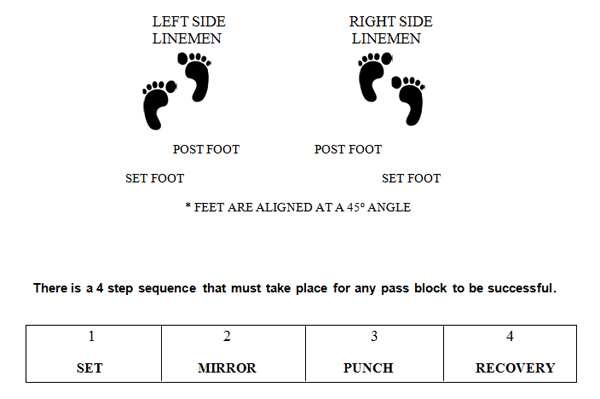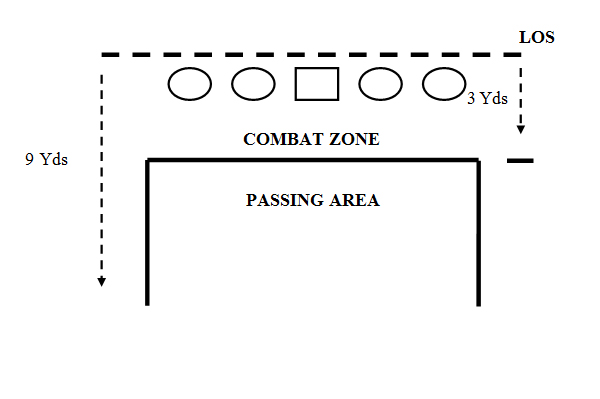| The Elements of Pass Protection
There are four areas in measuring the success of offensive linemen in pass protection. 1. The number of times the quarterback is flushed out of the pocket. When teaching pass protection it is imperative your offensive linemen understand the launch point of the quarterback. Why is it important? The launch point of the quarterback will change the pass rush angles of the defenders. The angles will even change from a 3 technique to a 5 technique, and so on depending on the depth of the quarterbacks drop. In pass protection the objective of an offensive lineman is to keep his body between the defender and the quarterback's launch point while maintaining the proper pass pro demeanor and relative position. What is relative position? The offensive lineman is keeping his rear-end to the quarterback while maintaining inside leverage and keeping the shoulders and hips square. What is inside leverage? Keeping the post foot just outside the foot of the defenders inside foot while maintaining inside leverage and never setting past the midline of the defender. Remember a great pass blocker must be disciplined in his technique while being patient but aggressive. A key to pass protection is how fast the offensive lineman can get from his three-point to his two-point stance without any wasted movement (the snap-up). As a coach you must train the eyes of your offensive linemen on where to look. Give them a target (inside or outside target, etc.). Offensive linemen must not lean on the defender (leaning on the hands and the head must not follow the hands); they must maintain the proper center of gravity, center of mass, as well as have a good base of support. The feet must be outside the hips throughout the pass block, the knees must stay within the ankles and the hips inside the knees (the cylinder). If the knees rotate outside the ankles the shoulder and hip will open up thus creating a soft hip and soft shoulder. Play on the insteps of the feet with the toes slightly out (toe out). Why on the insteps? If a pass protector plays on the balls of his feet he will fall forward unable to redirect his center of mass. If the pass protector plays on the heels of his feet, which is the most vulnerable part of the foot his mass is falling backwards and he will open up his hips and his shoulder because the foot will rotate out. Also, it is important to understand that the body is a cylinder and a pass protector must stay within his cylinder in pass protection. Once the pass protector is out of his cylinder he will loose power and balance. In other words the pass protector pass blocks with his hips. It is important to remember that every pass set is broken into four parts: Feet, Landmarks, Punch, and Knee bend.
The Set Foot: The outside foot. All cleats should be planted in the ground playing on the insteps and slightly toed out, while keeping the knee inside the ankle. If the weight is on the ball of the set foot the offensive lineman will be caught leaning and will be off balance. In pass protection having the ability to redirect and having balance is the key. |
 |
When teaching any type of pass protection drill have a redirect within that drill. Also, work on bad position drills. By teaching bad position drills in pass protection your offensive linemen will understand how to counter the bad position and work back to relative position.
|
 |


